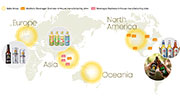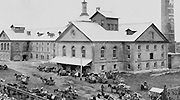GRI Standard Reference Table
GRI Standards
GRI 2: General Disclosures 2021
| 2-1 |
Organizational details |
|
| 2-2 |
Entities included in the organization’s sustainability reporting |
|
| 2-3 |
Reporting period, frequency and contact point |
|
| 2-4 |
Restatements of information |
|
| 2-5 |
External assurance |
|
| 2-6 |
Activities, value chain and other business relationships |
|
| 2-7 |
Employees |
|
| 2-8 |
Workers who are not employees |
|
| 2-9 |
Governance structure and composition |
|
| 2-10 |
Nomination and selection of the highest governance body |
|
| 2-11 |
Chair of the highest governance body |
|
| 2-12 |
Role of the highest governance body in overseeing the management of impacts |
|
| 2-13 |
Delegation of responsibility for managing impacts |
|
| 2-14 |
Role of the highest governance body in sustainability reporting |
|
| 2-15 |
Conflicts of interest |
|
| 2-16 |
Communication of critical concerns |
|
| 2-17 |
Collective knowledge of the highest governance body |
|
| 2-18 |
Evaluation of the performance of the highest governance body |
|
| 2-19 |
Remuneration policies |
|
| 2-20 |
Process to determine remuneration |
|
| 2-21 |
Annual total compensation ratio |
|
| 2-22 |
Statement on sustainable development strategy |
|
| 2-23 |
Policy commitments |
|
| 2-24 |
Policy Statement Practice |
|
| 2-25 |
Processes to remediate negative impacts |
|
| 2-26 |
Mechanisms for seeking advice and raising concerns |
|
| 2-27 |
Regulatory Compliance |
|
| 2-28 |
Membership associations |
|
| 2-29 |
Approach to stakeholder engagement |
|
| 2-30 |
Collective bargaining agreements |
|
GRI 3: Material Topics 2021
| 3-1 |
Process to determine material topics |
|
| 3-2 |
List of material topics |
|
| 3-3 |
Management of material topics |
|
Topic specific Standards
Economic
GRI201: Economic Performance 2016
| 201-1 |
Direct economic value generated and distributed |
|
| 201-2 |
Financial implications and other risks and opportunities due to climate change |
|
| 201-3 |
Defined benefit plan obligations and other retirement plans |
|
| 201-4 |
Financial assistance received from government |
|
GRI202: Market Presence 2016
| 202-1 |
Ratios of standard entry level wage by gender compared to local minimum wage |
|
| 202-2 |
Proportion of senior management hired from the local community |
|
GRI203: Indirect Economic Impacts 2016
| 203-1 |
Infrastructure investments and services supported |
|
| 203-2 |
Significant indirect economic impacts |
|
GRI204: Procurement Practices 2016
| 204-1 |
Proportion of spending on local suppliers |
|
GRI205: Anti-corruption 2016
| 205-1 |
Operations assessed for risks related to corruption |
|
| 205-2 |
Communication and training about anti-corruption policies and process |
|
| 205-3 |
Confirmed incidents of corruption and actions taken |
N/A |
GRI206: Anti-competitive Behavior 2016
| 206-1 |
Legal actions for anti-competitive behavior, anti-trust, and monopoly practices |
|
GRI207: Tax 2019
| 207-1 |
Approach to tax |
|
| 207-2 |
Tax governance, control, and risk management |
|
| 207-3 |
Stakeholder engagement and management of concerns related to tax |
|
| 207-4 |
Country-by-country reporting |
|
Environment
GRI301: Materials 2016
| 301-1 |
Materials used by weight or volume |
|
| 301-2 |
Recycled input materials used |
|
| 301-3 |
Reclaimed products and their packaging materials |
|
GRI302: Energy 2016
| 302-1 |
Energy consumption within the organization |
|
| 302-2 |
Energy consumption outside of the organization |
|
| 302-3 |
Energy intensity |
|
GRI303: Water 2018
| 303-1 |
Water withdrawal by source |
|
| 303-2 |
Water sources significantly affected by withdrawal of water |
|
| 303-3 |
Water recycled and reused |
|
| 303-4 |
Water discharge |
|
| 303-5 |
Water consumption |
|
GRI304: Biodiversity 2016
| 304-1 |
Operational sites owned, leased, managed in, or adjacent to, protected areas and areas of high biodiversity value outside protected areas |
|
| 304-2 |
Significant impacts of activities, products, and services on biodiversity |
|
| 304-3 |
Habitats protected or restored |
|
| 304-4 |
IUCN Red List species and national conservation list species with habitats in areas affected by operations |
|
GRI305: Emissions 2016
| 305-1 |
Direct (Scope 1) GHG emissions |
|
| 305-2 |
Energy indirect (Scope 2) GHG emissions |
|
| 305-3 |
Other indirect (Scope 3) GHG emissions |
|
| 305-4 |
GHG emissions intensity |
|
| 305-5 |
Reduction of GHG emissions |
|
| 305-6 |
Emissions of ozone-depleting substances (ODS) |
|
| 305-7 |
Nitrogen oxides (NOx), sulfur oxides (SOx), and other significant air emissions |
|
GRI306: Effluents and Waste 2020
| 306-1 |
Water discharge by quality and destination |
|
| 306-2 |
Waste by type and disposal method |
|
| 306-3 |
Significant spills |
|
| 306-4 |
Transport of hazardous waste |
|
| 306-5 |
Water bodies affected by water discharges and/or runoff |
|
GRI307: Environmental Compliance 2016
| 307-1 |
Non-compliance with environmental laws and regulations |
|
GRI308: Supplier Environmental Assessment 2016
| 308-1 |
New suppliers that were screened using environmental criteria |
|
| 308-2 |
Negative environmental impacts in the supply chain and actions taken |
|
Social
GRI401: Employment 2016
| 401-1 |
New employee hires and employee turnover |
|
| 401-2 |
Benefits provided to full-time employees that are not provided to temporary or part-time employees |
|
| 401-3 |
Parental leave |
|
GRI402: Labor/Management Relations 2016
| 402-1 |
Minimum notice periods regarding operational changes |
|
GRI403: Occupational Health and Safety 2016
| 403-1 |
Workers representation in formal joint management-worker health and safety committees |
|
| 403-2 |
Types of injury and rates of injury, occupational diseases, lost days, and absenteeism, and number of work-related fatalities |
|
| 403-3 |
Workers with high incidence or high risk of diseases related to their occupation |
|
| 403-4 |
Health and safety topics covered in formal agreements with trade unions |
|
| 403-5 |
Worker training on occupational health and safety |
|
| 403-6 |
Promotion of worker health |
|
| 403-7 |
Prevention and mitigation of occupational health and safety impacts directly linked by business relationships |
|
| 403-8 |
Workers covered by an occupational health and safety management system |
|
| 403-9 |
Work-related injuries |
|
| 403-10 |
Work-related ill health |
|
GRI404: Training and Education 2016
| 404-1 |
Average hours of training per year per employee |
|
| 404-2 |
Programs for upgrading employee skills and transition assistance programs |
|
| 404-3 |
Percentage of employees receiving regular performance and career development reviews |
|
GRI405: Diversity and Equal Opportunity 2016
| 405-1 |
Diversity of governance bodies and employees |
|
| 405-2 |
Ratio of basic salary and remuneration of women to men |
|
GRI406: Non-discrimination 2016
| 406-1 |
Incidents of discrimination and corrective actions taken |
|
GRI407: Freedom of Association and Collective Bargaining 2016
| 407-1 |
Operations and suppliers in which the right to freedom of association and collective bargaining may be at risk |
|
GRI408: Child Labor 2016
| 408-1 |
Operations and suppliers at significant risk for incidents of child labor |
|
GRI409: Forced or Compulsory Labor 2016
| 409-1 |
Operations and suppliers at significant risk for incidents of forced or compulsory labor |
|
GRI410: Security Practices 2016
| 410-1 |
Security personnel trained in human rights policies or procedures |
|
GRI411: Rights of Indigenous Peoples 2016
| 411-1 |
Incidents of violations involving rights of indigenous peoples |
N/A |
GRI412: Human Rights Assessment 2016
| 412-1 |
Operations that have been subject to human rights reviews or impact assessments |
|
| 412-2 |
Employee training on human rights policies or procedures |
|
| 412-3 |
Significant investment agreements and contracts that include human rights clauses or that underwent human rights screening |
|
GRI413: Local Communities 2016
| 413-1 |
Operations with local community engagement, impact assessments, and development programs |
|
| 413-2 |
Operations with significant actual and potential negative impacts on local communities |
|
GRI414: Supplier Social Assessment 2016
| 414-1 |
New suppliers that were screened using social criteria |
|
| 414-2 |
Negative social impacts in the supply chain and actions taken |
|
GRI415: Public Policy 2016
| 415-1 |
Political contributions |
The amount of political contributions in 2024 was 1.19 million yen. |
GRI416: Customer Health and Safety 2016
| 416-1 |
Assessment of the health and safety impacts of product and service categories |
|
| 416-2 |
Incidents of non-compliance concerning the health and safety impacts of products and services |
|
GRI417: Marketing and Labeling 2016
| 417-1 |
Requirements for product and service information and labeling |
|
| 417-2 |
Incidents of non-compliance concerning product and service information and labeling |
|
| 417-3 |
Incidents of non-compliance concerning marketing communications |
|
GRI418: Customer Privacy 2016
| 418-1 |
Substantiated complaints concerning breaches of customer privacy and losses of customer data |
|
GRI419: Socioeconomic Compliance 2016
| 419-1 |
Non-compliance with laws and regulations in the social and economic area |
|



















